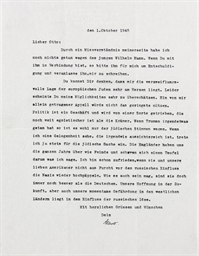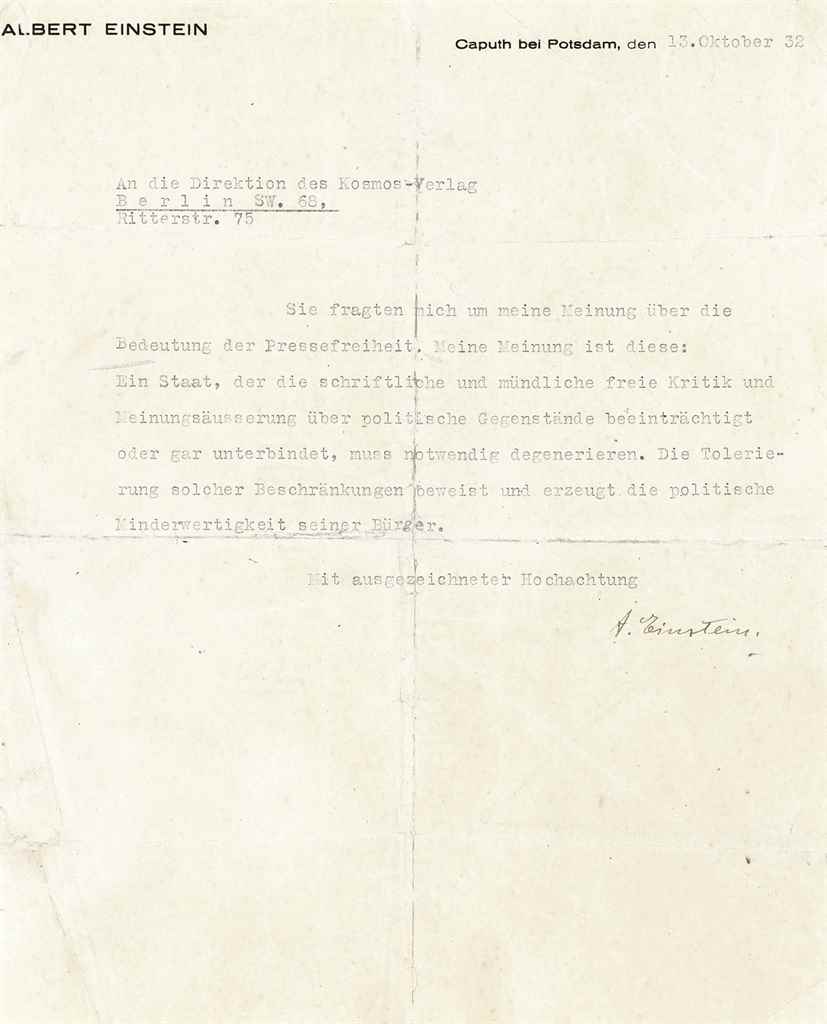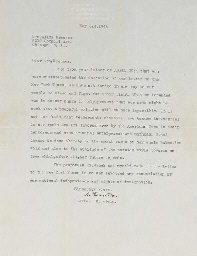EINSTEIN, ALBERT. Typed letter signed ("A. Einstein") to the physicist Robert S. Shankland, Department of Physics, Case Institute of Technology; Princeton, N.J., 17 September 1953. 1 full page, 4to, on Institute for Advanced Study stationery. "MY ADMIRATION FOR MICHELSON'S EXPERIMENT IS FOR THE INGENIOUS METHOD ..." Einstein's thoughtful comments on the work of several famous physicists including H.A. Lorentz (1853-1928), developer of the electron theory of matter and Albert A. Michelson. Einstein writes: "The Michelson-Gale experiment does, of course, concern the relativity question, but, as you mentioned yourself, not insofar as relativity theory differs from Lorentz' theory based on an ether at rest. My admiration for Michelson's experiment is for the ingenious method to compare the location of the interference pattern with the location of the image of the light source. In this way he overcomes the difficulty that we are not able to change the direction of the earth's rotation." Albert Abraham Michelson (1852-1931), the first American physicist to win a Nobel Prize (1907), accurately measured the speed of light in 1878, invented the inferometer for measuring distances by means of light waves and, in 1887, with E.W. Morley, performed a famous "ether-drift" experiment which demonstrated that there is no absolute motion of the Earth relative to the theoretical (but widely accepted) ether, a result which was a crucial starting point in the development of the theory of relativity. The Michelson-Gale experiment of the 1920s was a test for the effect of the Earth's rotation on the velocity of light. On the long-debated question of Einstein's knowledge of these experiments, prior to his own revolutionary 1905 relativity papers, see notes to preceding, and R.S. Shankland, "Michelson's Role in the Development of Relativity," in Applied Optics , 12:10 (October 1973).
EINSTEIN, ALBERT. Typed letter signed ("A. Einstein") to the physicist Robert S. Shankland, Department of Physics, Case Institute of Technology; Princeton, N.J., 17 September 1953. 1 full page, 4to, on Institute for Advanced Study stationery. "MY ADMIRATION FOR MICHELSON'S EXPERIMENT IS FOR THE INGENIOUS METHOD ..." Einstein's thoughtful comments on the work of several famous physicists including H.A. Lorentz (1853-1928), developer of the electron theory of matter and Albert A. Michelson. Einstein writes: "The Michelson-Gale experiment does, of course, concern the relativity question, but, as you mentioned yourself, not insofar as relativity theory differs from Lorentz' theory based on an ether at rest. My admiration for Michelson's experiment is for the ingenious method to compare the location of the interference pattern with the location of the image of the light source. In this way he overcomes the difficulty that we are not able to change the direction of the earth's rotation." Albert Abraham Michelson (1852-1931), the first American physicist to win a Nobel Prize (1907), accurately measured the speed of light in 1878, invented the inferometer for measuring distances by means of light waves and, in 1887, with E.W. Morley, performed a famous "ether-drift" experiment which demonstrated that there is no absolute motion of the Earth relative to the theoretical (but widely accepted) ether, a result which was a crucial starting point in the development of the theory of relativity. The Michelson-Gale experiment of the 1920s was a test for the effect of the Earth's rotation on the velocity of light. On the long-debated question of Einstein's knowledge of these experiments, prior to his own revolutionary 1905 relativity papers, see notes to preceding, and R.S. Shankland, "Michelson's Role in the Development of Relativity," in Applied Optics , 12:10 (October 1973).















Try LotSearch and its premium features for 7 days - without any costs!
Be notified automatically about new items in upcoming auctions.
Create an alert